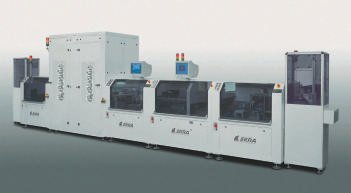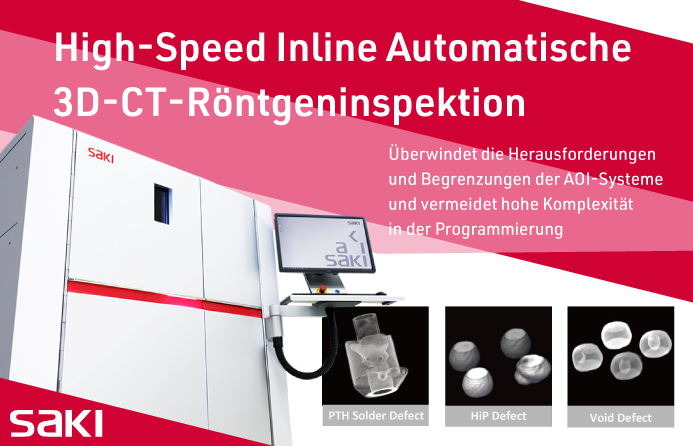Faster, better, more flexible. These requirements have top priority in setting up a screen printing/cleaning line from teaming firms Ekra and Systronic, to provide remarkable solutions for hybrid and solar technology. It’s possible now to process substrates with a maximum size of 205 x 305mm and a minimum thickness of 0.1mm.
Ralf Körner, Systronic, Karl Schanz, Ekra
Since every direct contact to the substrate is a potential source of faults, we used a conveyor belt transport system. It minimizes handling procedures and enables separate ways of transporting. This line enables processing of substrates in sizes of (for example) 4×4 and 4×6-in. There will not be any mechanical modification necessary, except for cluster printing. The programmable CCD camera takes images and positions the substrates; mounted on an XY table. This avoids time-consuming modifications when switching over to another size of substrate, and it meets high precision requirements. By means of two independently operating printing tables, the printing head and the imaging system can work synchronously.
The Ekra platform is designed for print rates of up to 1000 substrates per hour, and achieves an accuracy of ±15µm. By means of the special table design, a pre-contact to the printing table is possible. During the printing procedure, an exactly defined quantity of paste is sucked into the plated-through holes. This could guarantee a minimum coverage of 5µm at the hole edges. The screen printer is PC-controlled. All printing and imaging parameters can be saved. The substrates are fed either from cassette magazines or respectively for initial printing from a buffer unit. Before printing, a cleaning module (adhesion-based) removes dust and other particles from the surface of the substrates. After printing, the through-hole plating station follows, in which a safe contact with the backside by means of an efficient vacuum system is guaranteed. Since the substrates are touched at the edges only, a plating process with a minimum distance of 1,6mm to the edge is possible. After the plating, the visual inspection is realized in a double track configuration. This set-up enables controlling without production standstill and without touching substrate edges.
Due to cleanroom requirements, the substrate transport is provided only from below. This avoids contaminations by particles from above. Then a space-saving drying system follows, a Systronic vertical dryer. In order to realize the requested long-term temperature profile, as well as a yield of 1000 substrates per hour, the dryer has been designed as a double-track design. The substrates arriving from the inspection station are taken over by the track-change transport of the dryer and are delivered to two tracks. The edge contact is limited to 1,6mm (the same as for the entire line); this places high demands on the transport system.
The substrates are touch-less transported into cassette magazines to avoid wearing on the edges. After each loading, the magazines move one step above, so the following cassette can be loaded. In regard to the yield, every cycle of the dryer is controlled via its temperature profile. Even when traveling through the stainless-steel processing zone, the substrates are not moved in order to avoid any wear. The dryer features five separately controlled heating zones and a cooling zone, which fulfils every individual temperature profile requirement.
All parameter settings of the PC-controlled vertical dryer can be saved and printed, and therefore verified at any time. Before the substrates are re-magazined, they can be turned by 90, 180 or 270°. This assures that the substrates are properly put into the cassettes. As an option, there is a non-contact track available which transports the loaded magazine cassettes to the beginning of the production line, in order to apply another printed layer to the substrates.
But the empty magazines are transported to the starting point of the line. No operator intervention is necessary. Since the production is set up according to the principle of one-track-in-one-line, there is a clear functional distinction between each single module. Intervention of the operator is possible without problems and without particle contamination of a module. All control elements are placed at the reverse side and installed on slide frames. This provides easy access to all mechanical and electrical components.
EPP 174
Zusammenfassung
Ekra, Spezialist für Printprozesse, und Systronic als Lieferant eines Vertikal-Trockners haben zusammen einen Linie für die Fertigung von Hybriden und Solar-Panelen entwickelt. Hoher Ausstoß (bis 1000 Panels stündlich) und geringe Positioniertoleranzen dank Visionsystem (±15 Mikron) ermöglichen die präzise Bearbeitung von Platten bis zu 205 x 305 mm Abmessungen.
Résumé
Ekra, spécialiste des processus d’impression, et Systronic, fournisseur d’un séchoir vertical, ont développé en commun une ligne de fabrication d’hybrides et de panneaux solaires. Le rendement élevé (jusqu’à 1000 panneaux à l’heure) et les faibles tolérances de positionnement grâce à un système optique (w15 microns) autorisent un traitement précis de plaques mesurant jusqu’à 205 x 305 mm.
Sommario
La Ekra, specialista per processi di stampa e la Systronic come fornitore di un essiccatore verticale hanno sviluppato insieme una linea per la produzione di ibridi e di pannelli solari. Un’alta produttività (sino a 1000 pannelli/ora) e ridotte tolleranze di posizionamento grazie al sistema Vision (w15 micron) permettono di lavorare con la massima precisione pannelli sino a 205 x 305 mm.
Unsere Whitepaper-Empfehlung
Entdecken Sie wie die automatische Röntgeninspektion (3D-AXI) in höchster Geschwindigkeit mit zweifelsfrei klaren und detailreichen Bildern bestmögliche Produktqualität sichert und die Kosten senkt.
Teilen:











